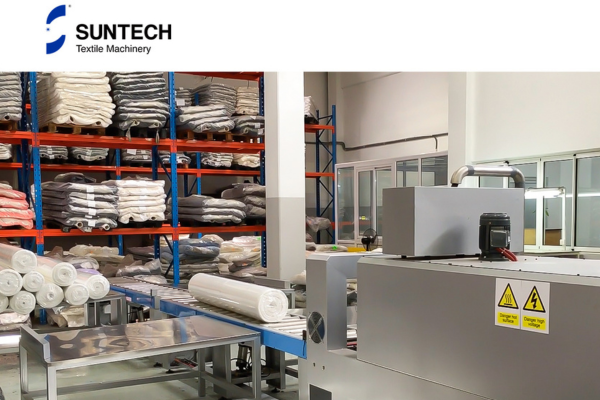In the ever-advancing textile production, maintaining efficiency is a key factor in improving competitiveness, and with it comes innovation in manufacturing processes. For example, the emergence of Automatic Fabric Roll Packing Machines has changed the way textiles are processed and packaged. In this article, we will explore how Automatic Fabric Roll Packing Machines reshape the textile industry, from improving efficiency to enhancing sustainability.
What Are Automatic Fabric Roll Packing Machines?
Automatic fabric roll packing machines are advanced systems designed to pack fabric rolls in an automated and efficient manner. These machines eliminate the need for manual labor, speeding up the packaging process and ensuring that every fabric roll is packed uniformly and securely. Equipped with functions such as automatic labeling, sealing, and vacuum packaging, they have become an indispensable part of modern textile manufacturing.
Fabric Roll Packing Workflow Integration
1. Fabric Input: The process begins with the placement of fabric rolls at the input station, setting the stage for a streamlined workflow.
2. Automated Unfurling: Robotic arms or automated devices gently unfold the fabric, preparing it for detailed inspection, ensuring that no damage occurs during this initial phase.
3. Industrial Camera Inspection: High-resolution cameras scan the fabric for any imperfections. This critical step utilizes sophisticated image processing technology to detect even the minutest flaws, safeguarding quality.
4. Manual Verification: When potential issues are detected, a secondary manual inspection is conducted. This ensures a double layer of quality control, reinforcing product integrity.
5. Efficient Packaging: Upon passing inspection, fabrics are automatically conveyed to the packaging area where they are sealed and prepared for dispatch. This process not only preserves the fabric's quality but also enhances packaging speed and consistency.
6. Labeling and Tracking: Labels containing key product information are printed and applied to each package. This facilitates easy tracking throughout the supply chain, improving logistics management.
7. Final Discharge: The fully packaged fabric rolls are then discharged from the line, ready for distribution or further processing. This final step marks the culmination of a highly efficient and automated process.
Advantages of Automatic Fabric Roll Packing
1. Enhanced Production Efficiency: The automation of critical steps such as inspection, packaging, and labeling dramatically accelerates production cycles, enabling higher throughput with less manpower.
2. Elevated Product Quality: The precision of automated systems, especially in fabric inspection, significantly reduces the risk of defects. This ensures that only the best-quality textiles reach the market, enhancing brand reputation.
3. Labor Reduction and Cost Efficiency: By minimizing the need for manual handling, the SUNTECH line reduces labor costs and associated risks. It also decreases the likelihood of human error, which can be costly in terms of both resources and product recalls.
4. Improved Worker Safety: Automated operations reduce the need for direct interaction with machinery, thus lowering the risk of workplace injuries. This not only protects employees but also reduces potential liabilities for manufacturers.
5. Operational Cost Savings: Beyond labor and safety, automated systems optimize material usage and reduce waste, contributing to significant cost reductions over time. Efficient processes also mean fewer returns and higher customer satisfaction rates.
6. Scalability and Flexibility: The SUNTECH is designed to be adaptable, and capable of handling various fabric types and sizes, making it an ideal solution for manufacturers looking to scale operations or diversify product offerings.
Conclusion
In addition to basic automated packaging, SUNTECH Automatic Fabric Roll Packing Machines can also be seamlessly integrated with fabric inspection machines, labeling, sorting and other functions to form a complete automated production line.
By integrating these advanced technologies, textile manufacturers such as textile mills can not only improve operational efficiency, but also adapt more easily to changing market demands and environmental standards. It is an inevitable trend for your textile business to continue to develop in terms of quality, efficiency and sustainability.
Contact us to experience the automation and intelligence of SUNTECH textile machinery. Redefine your production capabilities and gain market competitiveness.





